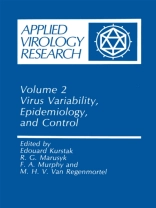Virus Variability and Impact on Epidemiology and Control of Diseases E. Kurstak and A. Hossain I. INTRODUCTION An important number of virus infections and their epidemic developments demonstrate that ineffec- tiveness of prevention measures is often due to the mutation rate and variability of viruses (Kurstak et al., 1984, 1987). The new human immunodeficiency retroviruses and old influenza viruses are only one among several examples of virus variation that prevent, or make very difficult. the production of reliable vaccines. It could be stated that the most important factor limiting the effectiveness of vaccines against virus infections is apparently virus variation. Not much is, how- ever, known about the factors influencing and responsible for the dramatically diverse patterns of virus variability. II. MUTATION RATE AND VARIABILITY OF HUMAN AND ANIMAL VIRUSES Mutation is undoubtedly the primary source of variation, and several reports in the literature suggest that extreme variability of some viruses may be a consequence of an unusually high mutation rate (Holland et al., 1982; Domingo et al., 1985; Smith and Inglis, 1987). The mutation rate of a virus is defined as the probability that during a single replication of the virus genome a particular nucleotide position is altered through substitution, deletion, insertion. or recombination. Different techniques have been utilized to measure virus mutation rates, and these have been noted in the extent of application to different viruses.
Edouard Kurstak & R.G. Marusyk
Virus Variability, Epidemiology and Control [PDF ebook]
Virus Variability, Epidemiology and Control [PDF ebook]
قم بشراء هذا الكتاب الإلكتروني واحصل على كتاب آخر مجانًا!
لغة الإنجليزية ● شكل PDF ● ISBN 9781475792713 ● محرر Edouard Kurstak & R.G. Marusyk ● الناشر Springer US ● نشرت 2013 ● للتحميل 3 مرات ● دقة EUR ● هوية شخصية 4617744 ● حماية النسخ Adobe DRM
يتطلب قارئ الكتاب الاليكتروني قادرة DRM












